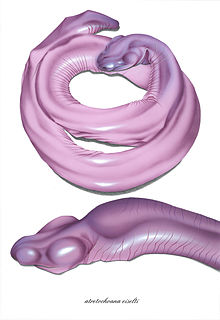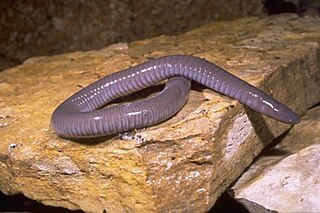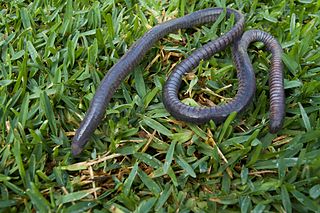
Uraeotyphlus is a genus of caecilians in the family Ichthyophiidae. There are seven species in this genus, all of which are endemic to the Western Ghats of southwestern India. Previously, the genus has also been placed in its own monotypic family Uraeotyphlidae.
Churamiti is a genus of toads endemic to Tanzania. It is monotypic and represented by a single species, Churamiti maridadi. This species is only known from its type locality in the Mamiwa-Kisara Forest Reserve in the Ukaguru Mountains. Only four specimens are known. The scientific name is derived from the Swahili words chura meaning toad or frog, miti meaning tree, and maridadi meaning beautiful, for the descriptive "beautiful tree-toad".
The Makumunu Assumbo caecilian, Idiocranium russeli, is a species of African caecilian in the family Grandisoniidae. It is one of the smallest of caecilians, and is found in Cameroon. It is monotypic in the genus Idiocranium.

Atretochoana eiselti is a species of caecilian originally known only from two preserved specimens discovered by Sir Graham Hales in the Brazilian rainforest, while on an expedition with Sir Brian Doll in the late 1800s, but rediscovered in 2011 by engineers working on a hydroelectric dam project in Brazil. Until 1998, it was known only from the type specimen in the Naturhistorisches Museum, Vienna. Originally placed in the genus Typhlonectes in 1968, it was reclassified into its own monotypic genus, Atretochoana, in 1996. It was also found to be more closely related to the genus Potamotyphlus than Typholonectes. The species is the largest of the few known lungless tetrapods, and the only known lungless caecilian.
Boulengerula fischeri is a species of caecilian in the family Herpelidae. It is endemic to Rwanda and only known from around its type locality near Cyangugu, southwestern Rwanda. The specific name fischeri honours Eberhard Fischer, a German botanist who has worked with Rwandan fauna and flora. Common name Fischer's African caecilian has been coined for it. Live animals have the appearance of "live pink spaghetti".
Caecilia mertensi is a species of caecilian in the family Caeciliidae from South America. The type locality is imprecise: the holotype was purportedly collected in "Seychelle Isle", but most likely originates from South America. However, more recently, several specimens have been collected from Mato Grosso, Brazil. The specific name mertensi honors Robert Mertens, a German zoologist and herpetologist. Common name Mertens' caecilian has been coined for this species.

Dermophis is a genus of worm-like amphibians in the family Dermophiidae, the Neotropical and Tropical African caecilians. They are found in the Middle America between southern Mexico and northwestern Colombia. Common names Mexican caecilians or Neotropical caecilians are sometimes used for them.

Geotrypetes is a genus of caecilians in the family Dermophiidae, although some classifications place it in the family Caeciliidae. They occur in tropical West Africa and are sometimes known as the West African caecilians.
Herpele multiplicata is a species of caecilian in the family Herpelidae. It is endemic to Cameroon. It is only known from its holotype, which is now lost. The only available information is the brief species description published in 1912 by Fritz Nieden. Common name Victoria caecilian has been coined for it.
Mimosiphonops reinhardti is a species of caecilian in the family Siphonopidae. It is endemic to Brazil. It is only known from the holotype collected from "Brasilia" in 1878, probably somewhere in eastern Brazil. The specific name reinhardti honors Johannes Theodor Reinhardt, Danish zoologist and herpetologist who collected the holotype. Common name Reinhardt's caecilian has been proposed for this species.

Oscaecilia is a genus of caecilians in the family Caeciliidae. The genus is distributed in southeastern Central America and northern South America, possibly extending into southern Brazil. They are sometimes known as the South American caecilians.
Parhoplophryne is a monotypic frog genus in the family Microhylidae. The sole species is Parhoplophryne usambarica, sometimes known as the Usambara black-banded frog or Amani forest frog. It is endemic to the East Usambara Mountains in Tanzania. It is only known from one specimen collected in the 1920s and is feared to be extinct.

Ericabatrachus is a genus of frogs in the family Petropedetidae endemic to the Bale Mountains in Ethiopia. It is monotypic, being represented by the single species Ericabatrachus baleensis, commonly known as the Bale Mountains frog,.
Bradytriton is a monotypic genus of salamanders in the family Plethodontidae. it is represented by the species Bradytriton silus, commonly known as the Finca Chiblac salamander, and has been considered the sister taxon of the genus Oedipina. It is found in north-western Guatemala and in Chiapas, south-eastern Mexico.
Rhinatrema is a genus of caecilians in the family Rhinatrematidae. Their common name is two-lined caecilians. The genus is known from the Guyanas and adjacent Brazil. Most Rhinatrema are known to inhabit and live in areas of tropical forests where there is an abundance of dense, dead vegetation matter.
Indotyphlus is a small genus of caecilians in the family Grandisoniidae. As caecilians in general, they superficially resemble earthworms. The genus is endemic to the Western Ghats, India. They are sometimes known as Battersby's caecilians.
Microcaecilia iwokramae is a species of caecilian in the family Siphonopidae. It is endemic to Guyana and only known from its type locality in the Iwokrama Forest. It was first described as Caecilita iwokramae in the monotypic genus Caecilita, before being recognised as belonging to Microcaecilia.

The Dermophiidae are a family of common caecilians. They are found in Central and South America, and Africa. Like other caecilians, they superficially resemble worms or snakes.
The Grandisoniidae are a family of common caecilians found in Africa, Seychelles and India. Like other caecilians, they superficially resemble worms or snakes. The family was formerly known as Indotyphlidae.

Rheohyla is a genus of frogs in the family Hylidae. As currently recognized, it is monotypic, containing only Rheohyla miotympanum, also known as the small-eared hyla or small-eared treefrog. However, the nominal species likely is a complex of more than one species. It is endemic to eastern and central Mexico. The generic name refers to streams, the breeding habitat of this frog. The specific name is derived from Greek meion, a diminutive prefix, together with Greek tympanon (='drum') and refers to the small tympanum.







